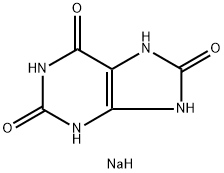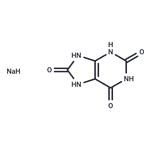
URIC ACID SODIUM SALT
- Product NameURIC ACID SODIUM SALT
- CAS1198-77-2
- CBNumberCB1667604
- MFC5H5N4NaO3
- MW192.11
- EINECS214-838-1
- MDL NumberMFCD00067310
- MOL File1198-77-2.mol
- MSDS FileSDS
Chemical Properties
| storage temp. | Store at -20°C |
| solubility | 1 M NaOH: 25 mg/ml |
| form | Solution may appear as a slightly hazy suspension. |
| color | Liquid |
| biological source | microbial synthetic |
| Stability | Stable. |
| CAS DataBase Reference | 1198-77-2 |
| FDA UNII | WA4Q622EWK |
| EPA Substance Registry System | 1H-Purine-2,6,8(3H)-trione, 7,9-dihydro-, monosodium salt (1198-77-2) |
| UNSPSC Code | 41106305 |
| NACRES | NA.51 |

